#electronic navigation charts
Explore tagged Tumblr posts
Text
Embracing Digital Transformation: Unlocking the Benefits of ECDIS Charts Discover the advantages of ECDIS charts, digital nautical publications, and electronic record books. Embrace digital transformation at AMNautical for efficient navigation.
#electronic navigation software#digital navigation charts#digital charts#nautical charts#electronic navigation charts
0 notes
Text
Top Features of Maritime GPS Systems Explained
The Stealth Runner, a cutting-edge patrol boat designed to protect Filipino fisherfolk in the West Philippine Sea, incorporates advanced equipment for enhanced operations. Beyond its robust hull and fortified wheelhouse, the Stealth Runner features state-of-the-art technology including civilian-grade Starlink for reliable communication, GPS for precise navigation, and fishing sonar for optimal…
#boat navigation technology#boat safety navigation#GPS for fishing vessels#GPS for sea vessels#marine electronics interface#maritime GPS systems#maritime technology innovations#nautical chart display#sailboat GPS features#user-friendly marine GPS
0 notes
Text
Neighbors pt.2
Frank Castle "The Punisher" x Male Reader
Summary: It's been almost a year since Frank walked into your apartment, revealing his life as The Punisher. You'd settled into a demanding routine as an overnight ER nurse, navigating that world alongside your relationship with Frank. Little did you know, those two worlds were about to collide.
A/N: I got a couple comments asking for a second part to the Neighbors fic, uh I wasn't exactly sure what to do with this so hopefully this is okay. Male nurse reader as well, cause we all know Frank would end up dead without you.
TW: Blood - Broken arm - Injury - Comfort


The automatic doors of the emergency room shrieked open, a violent gust of air preceding a surge of hurried footsteps and the staccato bursts of clipped radio chatter. Two EMTs, their faces etched with grim urgency, propelled a gurney through the opening. The insistent, rhythmic beeping of a cardiac monitor sliced through the already buzzing chaos, an electronic heartbeat in the pandemonium. "Thirty-something male, found unresponsive at the scene, possible overdose," one of the EMTs barked, his voice barely cutting through the din.
Across the crowded bay, a different kind of drama unfolded. Another pair of EMTs struggled to transfer a screaming elderly woman onto a hospital bed, her cries of pain echoing off the unforgiving linoleum floors. A young resident, his face pale and drawn under the harsh fluorescent lights, scribbled furiously on a chart, barking orders to a harried-looking nurse whose movements were a study in controlled frenzy.
You navigated this swirling vortex of controlled pandemonium, your own adrenaline still thrumming from the relentless stream of patients that had flooded in since your shift began what felt like an eternity ago. Just moments before, you had finished meticulously suturing a nasty, jagged gash on a construction worker’s forearm, the thick smell of antiseptic clinging to the air. Then the call came in – a multi-car pile-up on the highway. Now, you were heading towards the trauma bay, a knot of apprehension tightening in your stomach as you mentally braced yourself for whatever awaited.
The waiting room, visible through the smeared sliding glass doors, was a tableau of escalating anxiety. A young mother bounced a restless toddler on her knee, her eyes darting nervously towards the triage desk, a silent plea for information in their depths. An elderly man with a blood-soaked bandage wrapped around his head sat hunched over in a plastic chair, his face a roadmap of worry lines. The air in the waiting room hung thick and heavy, a cloying mix of antiseptic and raw fear, punctuated by the occasional, frustrated sigh that spoke volumes of unspoken dread. They didn't see the frantic ballet unfolding behind those closed doors, the life-and-death decisions being made in split seconds, the raw, visceral energy of a system stretched to its breaking point.
It felt like just moments ago, you had managed to coax a distraught teenager out of a full-blown panic attack, her rapid, shallow breaths and racing pulse fueled by pure, unadulterated fear of a phantom heart attack. Before that, it was a belligerent drunk, swinging wildly at anyone who dared to approach, requiring every ounce of your patience and a gentle yet firm hand to finally gain his cooperation. Each case, each individual, demanded a different kind of focus, a different wellspring of emotional and physical energy, leaving you feeling like a tightly wound spring threatening to snap.
As you pushed through the heavy swinging doors into the trauma bay, the scene intensified, the air crackling with a raw, visceral energy that made the hairs on your arms stand on end. The trauma team was already a well-oiled machine, each member moving with practiced precision, their movements economical and purposeful. A quick, sweeping glance told you the grim story: multiple injuries, a shocking amount of blood staining the sterile white sheets, the urgent, rhythmic whirring of suction machines battling to keep airways clear. You took a deep, steadying breath, pushing the gnawing fatigue that tugged at the edges of your awareness. Another life, or perhaps multiple lives, hung precariously in the balance, and in this moment, amidst the chaos, that was the only thing that mattered.
But before you could fully immerse yourself in the unfolding trauma, a hand clamped down on your arm, pulling you away from the organized chaos. It was Sarah, a newer nurse whose usual cheerful demeanor was replaced by wide, panicked eyes. "Hey! Can you come take a look at Mr. Wilson in room three? He's refusing his IV, and he's getting really agitated. I can't seem to get anywhere with him."
You let out a silent sigh. You knew the car crash victims were in capable hands for the moment, the experienced trauma team already orchestrating their care with practiced efficiency. Reluctantly, you nodded. "Okay, Sarah, let's go."
You walked down the quieter hallway towards room three, the frantic energy of the trauma bay fading slightly with each step. As you approached the open doorway, the distinct sound of a raised voice reached you. An older man sat propped up in the hospital bed, his face flushed with anger as he argued vehemently with another nurse, who held a saline-filled syringe aloft, looking increasingly frustrated.
You recognized the patient instantly. Mr. Wilson. A local elderly gentleman who was a frequent visitor to the ER, his unmanaged diabetes often landing him back in a hospital bed. He looked in your direction, his eyes, usually twinkling with a mischievous glint, now narrowed with annoyance, watching as you approached the hand sanitizer dispenser and meticulously washed your hands before pulling on a fresh pair of gloves.
"Oh, thank heavens you're here, Nurse," he huffed, his voice still carrying a note of indignation. "These youngsters don't got a clue what they're doing." He shot an accusatory glance at the two other nurses in the room.
You couldn't help but chuckle softly as you stepped closer to the bed. "They're doing their best, Mr. Wilson," you said gently, your tone calm and reassuring. You took the syringe from the other nurse. "Let's get this IV started, shall we?" Your practiced hands made quick work of locating a vein, the insertion smooth and efficient. Mr. Wilson barely flinched. "See? All done."
You shook your head slightly, turning around to grab his chart from the bedside table. "High blood sugar again?" You glanced over the recent lab results, noting the alarming number well over four hundred.
He waved a dismissive hand at you. "Nonsense, Nurse. I'll be right as rain, just like I always am."
You didn't respond immediately, taking a moment to ensure the IV was running smoothly before meeting his gaze. "I'll be back to check on you later, Mr. Wilson. Try to relax."
Hours bled into each other, the relentless tide of patients ebbing and flowing. Finally, as the first hint of dawn painted the sky outside the grimy windows, the ER began to quiet. You managed to steal a precious moment of respite in the cramped nurses' lounge.
Standing near the industrial-sized coffee maker, you pulled out your phone, a small beacon of normalcy in the chaotic day. A message from Frank, sent at the very beginning of your shift, greeted you. He often sent these little digital breadcrumbs – a silly meme, a brief update on his day, the occasional picture of him and your beloved pit bull, Frankie, their goofy faces a welcome distraction during your long, grueling hours. You tucked your phone back into your scrub pocket, the image of Frankie’s slobbery grin a momentary balm. You took the now-full coffee pitcher and poured yourself a much-needed cup, the rich aroma a small comfort.
You sank into a worn chair at one of the small, cluttered tables, barely managing a single, precious sip before the insistent buzz of your pager vibrated against your hip. With a heavy sigh, you pushed yourself to your feet, the brief moment of peace shattered. You headed back out to the bustling nurses' station, managing a tired smile for your coworker who handed you a chart. Your smile instantly froze, your blood running cold as you saw the name scrawled across the top: "Castle, Frank."
Without a word, your heart pounding a frantic rhythm against your ribs, you walked down the hall and into the designated exam room. The doctor was just hanging up a series of x-rays, the stark white images revealing the sharp break in Frank's arm. Another nurse was gently dabbing at a series of cuts and abrasions on his face and torso.
Frank's head snapped in your direction as the door creaked open, his eyes widening in surprise, then something akin to fear, as he registered the look on your face – a mixture of shock, disbelief, and a dawning anger. He watched, helpless, as the other nurse offered you a small, knowing smile and quietly slipped out of the room.
"You can't just leave me here with him," Frank pleaded, his voice laced with a theatrical desperation that didn't quite mask the underlying anxiety. "Common, babe." He groaned dramatically, leaning back against the pillows.
You didn't say a word, your mind still reeling. You simply set his chart down on the counter with a decisive thud and moved to the sink, the harsh fluorescent light reflecting off the cool metal as you meticulously washed your hands and pulled on a fresh pair of gloves, your movements stiff and deliberate. You picked up where the previous nurse had left off, gently cleaning the numerous cuts across his face and abdomen, your touch perhaps a little less gentle than it usually was.
Frank hissed, biting his lip as you carefully cleaned around a particularly deep gash on his side, the edges raw and angry-looking. "Fancy seeing you here," he attempted a weak joke, but instantly stopped when your eyes, usually warm and full of affection, now glinted with a sharp, almost dangerous light as you briefly glared up at him.
You listened in stony silence as the doctor began explaining the next steps, his voice calm and professional. "Alright, Frank, we're going to have to set that bone before we can put a cast on it. Looks like a clean fracture, but it needs to be realigned." He gestured to the x-rays. "We'll give you some local anesthetic for these cuts, and then we'll get started on the arm."
The doctor excused himself to gather the necessary supplies, leaving you alone with a very uncomfortable and apologetic-looking Frank. You picked up a syringe from the medical tray, the needle glinting under the bright lights, stopping just before taking the cap off.
"I've had a real shit day so far," you finally rasped, your voice tight with suppressed emotion. "Do you have any idea what was going through my mind when I saw your name on that chart?" You didn't wait for an answer, your silence hanging heavy in the air.
Frank let out a long, weary sigh, wishing he had just listened to his gut and insisted they not contact you. "I'm sorry, trust me, baby, I didn't mean to worry you." He groaned, shifting uncomfortably on the examination table.
You finally took the cap off the syringe, your movements precise and efficient despite the turmoil churning within you. You swabbed the area around the deep laceration on Frank's side with a cold alcohol wipe. "It's gonna sting," you whispered, your voice barely audible, before carefully pushing the tip of the needle into various points around the wound, injecting the numbing solution. Your chest tightened almost imperceptibly as he occasionally hissed in pain, his free hand instinctively reaching out to grip the sleeve of your scrubs, his knuckles white.
With the local anesthetic administered, you began to meticulously stitch the wound, your movements quick and precise, years of training taking over despite the emotional turmoil. Each careful stitch pulled the edges of the laceration together, closing the angry red gash. Once finished, you applied a clean bandage over the area.
You stood up straight, disposing of the used needle and other medical supplies with a sharp, efficient clink into the biohazard bin. Your back was to Frank as you bent over the sink to wash your hands, the sound of running water filling the brief silence. You heard a low whistle from behind you, a familiar sound that couldn't help but tug the corner of your lips into a small, involuntary smile.
You turned around, one eyebrow cocked in amusement. "Incredibly unprofessional, Mr. Castle," you quipped, a hint of your usual playful tone finally breaking through the tension.
"Can't help that my nurse looks incredibly hot in his scrubs," Frank hummed, a sheepish grin spreading across his face.
You walked back over to the side of the bed, leaning down to press a quick, chaste kiss to his lips. Frank’s hand, no longer gripping the mattress, came to rest gently on the small of your back, pulling you a fraction closer as he returned the kiss. You quickly pulled away when the door creaked open again, the doctor returning with a tray of casting materials.
He simply shrugged, a knowing smirk playing on his lips. "If kissing your boyfriend at work was illegal, half the staff here would be unemployed by now."
You couldn't help but laugh, the absurdity of the situation finally breaking the tension. You walked around the bed to help the doctor, a familiar camaraderie settling between you as you assisted him in the procedure.
The doctor explained the process as he worked, his tone calm and matter-of-fact. You carefully stabilized Frank's arm above and below the fracture site as the doctor applied traction and expertly manipulated the bone back into alignment. Frank winced but remained relatively still, his gaze locked on yours. The sickening thunk of the bone resetting made you flinch, but relief washed over Frank’s face. The doctor then carefully wrapped Frank's arm in layers of padding and wet plaster, molding it into a supportive cast.
Once the cast was securely in place, the doctor gave Frank instructions on how to care for it and left the two of you alone again. You stayed behind in the quiet exam room with Frank, pulling a couple of warm blankets over him and double-checking that his IV was running smoothly. He watched your every move, his eyes soft and full of affection. Just as you were about to leave, his hand reached out, his fingers gently closing around your wrist.
You turned back, leaning down to press a tender kiss to his lips. "I'll take you home once my shift's over," you murmured against his mouth. "Just get some rest for now."
Frank kissed you back, his grip on your wrist loosening slightly. "I love you," he whispered, his voice thick with exhaustion and perhaps a touch of lingering pain medication.
"I love you too," you replied softly, stroking his cheek. "But please, for the love of all that is holy, don't show up at my work again unless it's to bring me food." You managed a weak joke, and Frank chuckled, a low, rumbling sound that eased some of the tightness in your chest.
#frank castle#frank castle x male reader#the punisher#the punisher x male reader#marvel frank castle#marvel x male reader#marvel#mlm#fanfic#fanfiction#x male reader#xmalereader#requested
92 notes
·
View notes
Text
Miata Mod Master Mᴉsɥlᴉsʇ
[I had to spell Wishlist upside down to keep the alliteration going]
So, here's my first original post in quite a while. Apparently, the last one was a whole hundred followers ago - immense thanks to all 400 of you!!! And also, Tumblr informed me I got 1000 likes and kindly generated a picture for me to thank y'all for them with!

Given that's 2.5 likes per follower, I assume they mean 1000 likes just on my original posts, which would track considering most of my posts are additions, and liking all of those either counts towards that tally as just one like to my original post, or if you liked it through a reblog potentially nothing at all, because maybe likes to reblogs aren't counted even if they're reblogs of my own posts. But don't think I'm a numbers-chaser, this is just me wondering. Really, the only reason I even look at the activity chart of my blog is because I started trying to make that line as straight as possible for giggles (and then some of my posts blew up and ruined it, ecksdee). The thought of someone having enjoyed what I wrote has me smitten every time I see it, and I can barely even comprehend the idea that it happened a literal thousand times. I still can barely wrap my head around four hundred people all having decided they actively want to hear more from me. (Usually it's the opposite, har har.) I love all of you for it. The freaks, the puritans, the children (wait I just said that OOH GOTTEM), the adults, the uncomfortably weird, the hyper-organized users that use different blogs for each one of their passions, the hyper-random users that reblog my posts right after diaper fetish art. (And if you thought that was some whiplash, imagine the guy who followed a diaper fetish art blog getting shown me.)
But this is just me buying time, isn't it. Alright alright, let's talk about the wishlist, beginning with its premise.
This is not advice. This is not a list that makes sense at all, really - most of these items are way far down the list of things I'd do with the money they cost and/or the effort they'd take. This is a dream, where those aren't a factor. Just like some people's dream car is a ten million dollar hypercar that was built directly into the bodies of five Middle Eastern oil moguls, my dream car is a Miata with exactly these bits. (And a Seven, but I really need to stop confusing y'all with them being tied for the favorite car top spot.)
This list is based on a note I started in middle school for the fun of it (which is hopefully understood as the driving motive behind this all) and gradually updated through high school and sort of left behind after that, having kind of run out of bits to add to it. It's split into six sections:
Exterior
Interior (i.e. cabin, trunk and engine bay)
Drivetrain (i.e. anything that plays a role in making the wheels spin)
Chassis and suspension (i.e. chassis and everything that connects the wheels to it)
Electronics (i.e. electronics/microcontroller-related features)
Miscellaneous
This will be a chance for me to check the prices of all the things I listed and, at the end of it, tally up their total cost and feel feelings about its enormity. But of course, we'll need to start with a thing that was not in the note, as it was a given to me: the base car. So that will be the subject of my next addition to this post.
Because I can't make this a single post. Absolutely no chance. Even just any workaround to the image limit being about a fifth of the length of this list would be a nightmare for me to execute and for y'all to navigate. And frankly, the length of the task would make me, if not outright give up, at the very least skimp on the kind of explanations and discussions that I must assume are why you're all here. So I will need to make additions to this post (in the form of a reblog, of course) each going over one section at most. But truth be, even doing one reblog per section presents those problems, so some sections would need splitting in a number of parts. Or I could go to the other extreme and made one post per item (or when appropriate group of items), which would allow me to expand upon every which one as little or as much as appropriate while still keeping a tidy presentation. But to do this I would need to hide all the information bar the name under a Read More, because if I put as little as one picture before it by the time I'm at the end of the list every time this post appears in your dash you'll have to scroll past some hundred pictures to get to the bottom of it; also, of course, this would mean this post showing up in your dash upwards of a hundred times - though of course you could just ignore it a bunch of times and when you feel like it go through all the parts you've not read yet at once.
Right now I'm leaning towards the one post per item approach, which would allow me to work towards the completion of this abomination in small daily steps rather than in age-long parts which would also help addressing your other submissions. But it's very hard for me to figure out what y'all would prefer, as it's kind of hard for me to figure out who would actually want to read through the entirety of this. So, y'all are welcome to leave your feedback in the replies or through this non-binding format poll.
Links in blue are posts of mine about the topic in question - if you liked this post, you might like those!
#i would have set something like two or three days but since day and week are the only options week it is#tumblr milestone#thank you#i am pretty sure those were tags included with the post but you know what I feel them so let's leave them in#mazda miata#mazda mx-5#eunos roadster#miata mod master wishlist
92 notes
·
View notes
Text
In the vibrant landscape of 1980s pop, George Michael’s Monkey emerges as a masterclass in blending infectious energy with poignant storytelling.
youtube
Released in 1988 as part of the Faith album, the single version—reimagined by production maestros Jimmy Jam and Terry Lewis—radiates a polished, dancefloor-ready sheen that elevates it beyond its album counterpart. The track’s crisp Roland TR-808 cowbell and pulsating Linn 9000 rhythms carve out a distinctive pop-funk groove, marrying electronic precision with an organic, soulful swagger. This sonic alchemy transforms Monkey into a chart-conquering force, claiming the #1 spot on the Billboard Hot 100 and cementing its place as Michael’s first dance chart triumph.
Monkey is a lyrical gem, wielding the metaphor of a “monkey” to depict the relentless grip of drug addiction on a relationship. With lines like “Do you love the monkey or do you love me?”, Michael delivers a raw, universal plea that resonates with emotional clarity. His vocal performance—sultry, commanding, and effortlessly versatile—navigates the song’s quirky melody with finesse, balancing upbeat pop sensibilities with the weight of its narrative. The unconventional structure, paired with irresistible hooks, showcases Michael’s songwriting prowess, crafting a track that’s both commercially magnetic and artistically bold.
The song’s execution is amplified by its dynamic arrangement, where tight rhythms and vibrant shifts create a canvas for Michael’s electrifying stage presence. What sets Monkey apart is its timelessness. Unlike some 80s tracks tethered to their era, its universal themes and pristine production transcend decades, sounding as fresh today as in 1988. Yet, despite its accolades, the song remains curiously underappreciated, often overlooked in favor of Michael’s more celebrated hits. This oversight belies its brilliance—a testament to Michael’s genius at 23, when he wrote, produced, and played most of Faith’s instruments.
Monkey stands as a vibrant, soul-stirring anthem, its infectious rhythm and emotional depth proving that great music doesn’t just endure; it electrifies, challenges, and inspires across generations.
Year: 1987
Composer/Lyrics: George Michael
Producer: George Michael, Jimmy Jam, Terry Lewis
youtube
youtube
youtube
youtube
youtube
youtube
youtube
youtube
youtube
#music#music review#review#80s#80s music#80s pop#George Michael#Jimmy Jam#Terry Lewis#dancefloor#dance#Youtube
5 notes
·
View notes
Text
Essential Safety Equipment for Boats: Stay Safe on the Water
Boating is an exciting adventure, whether you're fishing, cruising, or simply enjoying a day out on the water. However, safety should always come first! Having the right safety equipment on board can mean the difference between a great day and a dangerous situation. Here’s a list of must-have safety gear every boat owner should have.
1. Life Jackets (Personal Flotation Devices - PFDs)
Life jackets are the most crucial piece of safety equipment on any boat. Ensure you have U.S. Coast Guard-approved PFDs for every person on board, including children. Even strong swimmers need them in emergencies!
Pro Tip: Check that life jackets fit properly and are in good condition before every trip.
2. Throwable Flotation Device
Aside from wearable life jackets, boats over a certain size must carry at least one throwable flotation device, like a ring buoy or floating cushion. This is essential for rescuing someone who falls overboard.
3. Fire Extinguishers
Fires on boats are rare but can be catastrophic. Having a marine-grade fire extinguisher is mandatory for most boats, especially those with enclosed engines or fuel storage. Make sure it’s properly maintained and easily accessible.
4. Emergency Signaling Devices
In case of an emergency, you need a way to signal for help. Essential items include:
Flares or Distress Signals: Help rescuers locate you, especially at night.
Whistle or Horn: For alerting nearby boats.
VHF Radio: A reliable way to communicate with the Coast Guard and other boaters.
5. Navigation Lights
If you're boating at night or in low-visibility conditions, proper navigation lights help others see you and avoid collisions. Regularly check that your lights are functioning correctly.
6. First Aid Kit
Accidents can happen anywhere, and being on the water means medical help might not be nearby. A well-stocked first aid kit should include bandages, antiseptics, pain relievers, seasickness medication, and other essentials.
7. Bilge Pump or Bailer
If water starts entering your boat, you’ll need a way to remove it quickly. Automatic bilge pumps are ideal for larger boats, while smaller vessels should have a manual bailer or bucket.
8. Anchor with Rope
An anchor helps you stay in place, preventing your boat from drifting into danger if the engine fails or strong currents arise. Make sure your anchor is the right size for your boat and the waters you navigate.
9. Emergency Tool Kit & Spare Parts
Mechanical issues can leave you stranded. A small tool kit with basic supplies—such as screwdrivers, wrenches, spare fuses, and extra fuel filters—can be a lifesaver.
10. Weather and Navigation Tools
Staying informed about weather conditions can prevent accidents. Equip your boat with:
A waterproof GPS or marine chart
A barometer or weather radio
A compass in case electronic systems fail
2 notes
·
View notes
Text
Cmas count your days
The Real Racist Story Behind Beyoncé’s Upcoming 'Cowboy Carter' Album
The legendary pop star is on a revenge tour with "Cowboy Carter," her first Country album.

Ever since Beyoncé showed up at the Grammys last month rocking a pristine cowboy hat and followed up a week later with a Beyhive-breaking album announcement and surprise two-piece release at Super Bowl LVIII, the internet has been alight with conjecture on why she took a very unexpected foray into Country music.
Will she ever release straight pop music again? Is she coming for Taylor Swift’s crown since that chick keeps getting awards she deserves? Is she simply seeking to dominate various genres, as she did electronic music with the 2022 “Renaissance” album? Is a Celtic New Age album next??
Well, Beyoncé gave us some insight on Instagram this week, posting the album cover to her upcoming eighth studio album “Cowboy Carter,” along with a message to kick off the 10-day countdown to the album’s March 29 release.
“It was born out of an experience that I had years ago where I did not feel welcomed…and it was very clear that I wasn’t. But, because of that experience, I did a deeper dive into the history of Country music and studied our rich musical archive,” she wrote.
She (unsurprisingly) didn’t expound on the “experience,” but it’s largely assumed that Bey was referencing her 2016 performance at the Country Music Awards, where she joined The Chicks (formerly The Dixie Chicks) to perform “Daddy Lessons” from her magnum opus “Lemonade.” (The group had been performing their version of her song on tour.)Beyoncé and Dixie Chicks - Daddy Lessons ( LIVE at CMA Awards 2016 )
Despite apparently being the most highly rated 15 minutes in the history of the CMAs, the (white) folks in the audience and at home didn’t know what to do with an actual Black woman daring to hit “their” stage without a mop and some Clorox.
The CMAs apparently got so much negative flak from the performance of Bey and The Chicks (who infamously endured their own battle with Country’s rootin’ tootin’ powers that be) that it folded like gym towels and took the performance off its platforms — only to buckle to even greater outrage a day later and put it back up…proving that the CMAs mama still apparently tells it what to do. Natalie Maines on the Racist Comments She & Beyoncé Got After Performing at the CMAs
That one of the five largest music stars on the planet somehow managed to get shade from the Grammys and the Country Music Awards notwithstanding, Justin Timberlake hit the CMA stage one year earlier to perform with nominated artist Chris Stapleton. He and Bey are effectively pop music peers, but no angry phone calls or de-platformed video for him. Hmm…I wonder why(te)…?
Indeed, Country music and racism have been bedfellows for quite some time, as the genre is the domain of the rebel flag, minimal bass, the wrong side of the Mason Dixon Line and earnest tunes about the “real America” that doesn’t involve you woke Negroes. That’s why when Black artists do permeate Country, their narrative almost always involves how they navigate a genre that isn’t very friendly to them.
Yet when Country borrows from Black artists to powerful impact, as Luke Combs did with his chart-topping 2023 remake of Tracy Chapman’s 1988 classic “Fast Car” — which brought her back outside after decades and with immaculate skin — all is good among the racists, I guess.
So, just as when an openly gay, dark-skinned Lil Nas X had the good ol’ boys stomping their trucker hats in the dirt when he dominated (and confounded) Country for at least a year with his “Old Town Road” remix, Bey will drop “Country Carter” next week and her nonpareil influence will have residents of every Martin Luther King, Jr. Blvd. in the country buying their first Country album.
Shit that the genre has never seen is about to go down. So, gird your loins, white folks: Country music is about to have way more bodysuits and silver.
Sent from my iPhone
#Me thinking about#how this album#was created because#the CMAs treated#Beyonce like crap….#lemons into#the finest of lemonade.#😭🫶🏾✨#COWBOYCARTER#Cowboy carter#queen bey#act ii#act ii cowboy carter#beyonce#beyhive#renaissance world tour#16 carriages#cowboy carter#Beyonce#country music#cuntry#texas holdem#Youtube#Black music#black musicians#country#blackbird#the beatles#beatles#beatlemania
3 notes
·
View notes
Text
Secure and Efficient: Modern Techniques in Credit Card Payment Processing
Article by Jonathan Bomser | CEO | Accept-Credit-Cards-Now.com

In the whirlwind of commerce, the bedrock of modern business operations lies in the art of Credit Card Payment Processing. Efficiently and securely managing credit card payments is the linchpin, especially in the high-stakes arenas of high-risk credit card processing, e-commerce, credit repair, and CBD merchant services. This exploration delves into the avant-garde strategies and techniques that businesses are deploying to ensure a marriage of both security and efficiency in credit card payment processing within today's digital landscape.
DOWNLOAD THE SECURE AND EFFICIENT INFOGRAPHIC HERE
Charting the Evolution of Payment Processing
From the analog days of paper checks and cash transactions, the trajectory of payment processing has undergone a metamorphosis. In the current digital epoch, where electronic transactions reign supreme, staying abreast of cutting-edge payment processing technology is imperative. Whether navigating the labyrinth of high-risk industries or steering the ship of e-commerce ventures, the mandate is clear – stay secure and efficient.
High-Risk Credit Card Processing: Navigating the Perils
Industries like credit repair and CBD often find themselves sailing turbulent high-risk seas due to stringent regulations and perceived risk factors. However, being earmarked as high-risk need not be a roadblock; it can be a catalyst for thriving. The key lies in embracing modern techniques tailored for high-risk credit card processing.
Effectively navigating risks calls for strategic partnerships with payment processing providers who specialize in high-risk transactions. These providers offer bespoke solutions, navigating the labyrinth of complexities and shielding businesses from potential pitfalls.
E-commerce Merchant Accounts: Anchors in the Online Sphere
In the theater of online commerce, e-commerce merchant accounts emerge as stalwart anchors. These accounts empower businesses to securely hoist the sails for payments over the internet, whether it's a nimble online store or a grand e-commerce platform. The article underscores the pivotal role of reliable e-commerce merchant accounts, advocating for features that align with diverse business needs, from seamless integration capabilities to robust fraud prevention tools.
Credit Repair Payment Gateway: Paving Effortless Paths
For credit repair enterprises, a dedicated credit repair payment gateway becomes the captain's wheel. This specialized gateway streamlines financial voyages, ensuring the secure handling of sensitive financial data. The article accentuates the importance of selecting credit repair payment gateways with formidable security features like encryption and tokenization. A user-friendly interface and compatibility with various credit cards become the north star for elevating the customer experience.
CBD Merchant Processing: Sailing the High-Risk Seas Safely
CBD merchants, navigating the high-risk seas due to the industry's association with cannabis, find solace in modern techniques. To chart a course to success in CBD merchant processing, adopting strategies that mitigate risks and ensure smooth operations becomes imperative.
Strategic alliances with CBD merchant processing providers, well-versed in industry intricacies, are paramount. These providers furnish tailored payment processing solutions, and coupled with specialized credit card payment services, enable businesses to efficiently and securely accept credit card payments.
The Dominance of Payment Gateway Solutions
In the contemporary business amphitheater, payment gateway solutions emerge as indispensable orchestra conductors for facilitating online transactions. Acting as the harmonious bridge between websites or apps and financial institutions, the right payment gateway orchestrates a seamless payment symphony. The article urges businesses to select payment gateways boasting a symphony of features, including real-time transaction processing, advanced fraud detection, and harmonious integration capabilities.
Credit Card Payment Services: Elevating Operational Sonatas
Operational sonatas take center stage in the grand performance of credit card payment processing. Businesses adept at orchestrating payments swiftly and accurately gain a competitive edge. Modern credit card payment services, offering a symphony of features like mobile payments, contactless payments, and online account management, become instrumental in achieving this symphonic efficiency. The article champions the adoption of these services to serenade a broader audience and provide a harmonious payment experience that crescendos into customer loyalty.
youtube
Embrace Modernization for a Flourishing Finale
In the realm of Credit Card Payment Processing, the symphony of evolution plays out rapidly, demanding businesses to conduct themselves to stay competitive. Whether traversing the landscape of high-risk industries, e-commerce, credit repair, or CBD merchant services, embracing modern techniques becomes the crescendo for success.
Strategic partnerships with specialized providers well-versed in industry intricacies become an essential note. Investments in e-commerce merchant accounts, credit repair payment gateways, and CBD merchant processing solutions, harmonizing both security and efficiency, are advocated. Leveraging payment gateway solutions and credit card payment services, businesses can elevate their operational symphonies.
As technology continues its relentless crescendo, securing both security and efficiency in credit card payment processing isn't just advisable; it's the grand finale. This ensures a seamless symphony of payment experiences for customers and charts a path for businesses to flourish in the digital age. The clarion call is to embrace modernization today and compose a prosperous future for your business. With Accept-Credit-Cards-Now Merchant processing services as your virtuoso, the symphony becomes smoother and more secure.
#high risk merchant account#payment processing#high risk payment gateway#credit card processing#high risk payment processing#youtube#accept credit cards#credit card payment#merchant processing#payment#Youtube
13 notes
·
View notes
Text
I found a story authored by persons unknown. It appears to be another account of humanity's diaspora and travels through the void.
In his thirty-two years alive, James had never experienced such quiet. The cramped, busy cells of the Vimana were always filled with conversation, the shuffling of feet, and the exchange of navigation data. Today though, no voices echoed, everyone’s feet remained rooted in place at their stations, and all information was conveyed digitally to reduce miscommunication. For today was the first day since any of them had ever been alive where the Vimana changed course. Its departure from the Flotilla had not been an easy one; with countless objections from equally countless crews, all decrying their decision as irresponsible at best, and willfully damning at worst. Even so, no-one stopped the vessel as it slowly turned, decelerated, and calculated an intercept.
No-one aboard could leave their fellows to their fate. Her captain broke the silence.
“Navigation, status update.” His voice was flat; devoid of the turbulent emotions he undoubtedly felt. He could have issued the command electronically, but James suspected they all needed to hear something other than hushed breaths.
A stiff woman’s eyes darted between equations, diagnostics, and vector information as she responded.
“Vimana has successfully charted an intercept to the last known vector of the Greybeard. We should be able to detect her beacon, barring total destruction, within a seven parsec radius of her location, time to intercept between four to eight hours local time depending on if they ever managed repair.” James marveled at the woman, his wife Anika, as she spoke. He couldn’t see a single muscle move that she didn’t need. An individual of exceptional efficiency in everything she did. There was none aboard that could match her speed and accuracy in navigational calculations.
If they ever managed repair. James anguished at the meaning behind the simple sentence. The Greybeard had reported a cascading drive failure only three hours before the Vimana changed course, but the relativity wake caused by the Zephyr drive means entire decades could have passed for their crew in those few, short hours. Anything could have happened to them. James knew people on that ship, good people. Likely dead or, best case, twice their previous age now. The silence once again smothered the vessel like the very wave they ran from. The vector was set, the flotilla abandoned. Nothing to do but wait and listen.
The Blackwave- James began to think, the captain’s sharp voice cutting the thought short, seemingly finishing it.
“Time to Blackwave overtake, Navigation?” Anika’s eyes flashed as she parsed the math in her mind’s eye.
“At this vector, seven point eight-three hours, local time.” James noticed an almost imperceptible change in the captain, as if he was grasped by despair itself, only to scare it off. Nonetheless, the captain stared ahead, his countenance statuesque.
“Continue on-vector, Navigation.”
2 notes
·
View notes
Text
IETM for Beginners A Quick Guide to IETM Code and Pixels
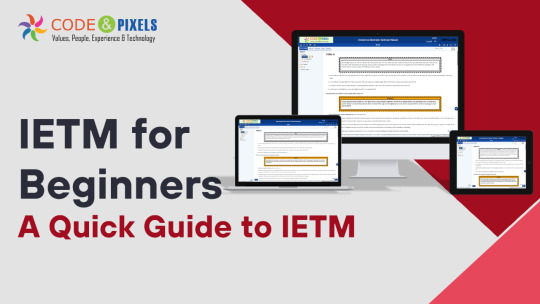
IETM: Interactive Electronic Technical Manual
Training Aids to Defence Client
If you are a supplier of defence then along with the system/equipment you also need to provide Training Aids
(CBT) — Computer-Based Training
Charts and Bloups
Video Film
Training Work Modules
Manuals Hard Copies
IETM
Evolution of Documentation in Defence
Before — Hardcopies and PDFs in DVDs (Upto 2015)
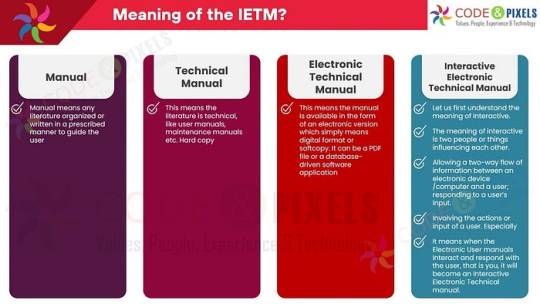
What is the meaning of the IETM?
Manual: Manual means any literature organized or written in a prescribed manner to guide the user.
TechnicalManual: This means the literature is technical, like user manuals, maintenance manuals etc. Hard copy
Electronic Technical Manual: This means the manual is available in the form of an electronic version which simply means digital format or softcopy. It can be a PDF file or a database-driven software application.
Interactive Electronic Technical Manual:
Let us first understand the meaning of Interactive. The meaning of interactive is two people or things influencing each other.
Allowing a two-way flow of information between an electronic device /computer and a user; responding to a user’s input.
Involving the actions or input of a user. Especially
It means when the Electronic User manuals Interact and respond with the user, that is you, it will become an Interactive Electronic Technical manual.
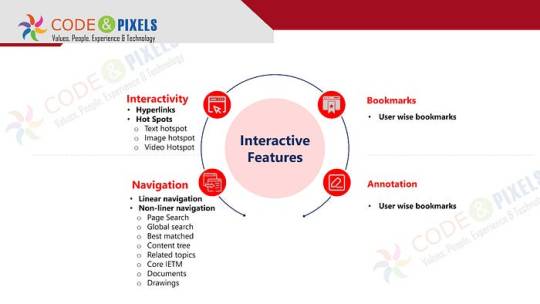
Interactive Features
Interactivity
Hyperlinks
Hot Spots
Text hotspot
Image hotspot
VideHotspot
Bookmarks
User wise bookmarks
Navigation
Linear navigation
Non-liner navigation
Page Search
Global search
Best matched
Content tree
Related topics
Core IETM
Documents
Drawings
Annotation
User wise bookmarks
The documents and pages are many hence, for easy and fast accessibility complete content is converted and stored as a database.
Whenever the user wants some information, IETM software produces the information in a fraction of a second.
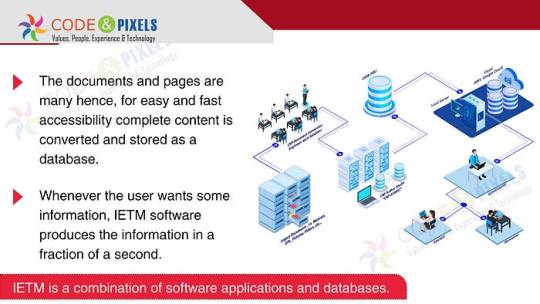
Use or Purpose of the IETM?
The purpose of the Manual is to give information related to the equipment to the end user for quick reference.
All the technicality is written in detail so that when an issue arises, the user can refer to the manual, as every time OEM or technical person or subject matter expert might not be available on the spot to resolve the issue.
If the manual has 10 pages users can refer easily.
But any system used by the defence will have multiple manuals and thousands of page counts and many times a user has to cross-refer between manuals, intra-manual and inter-manual to resolve the issue.
Referring to 10- 15 hard-copy or even soft-copy books simultaneously will be difficult and time-consuming.
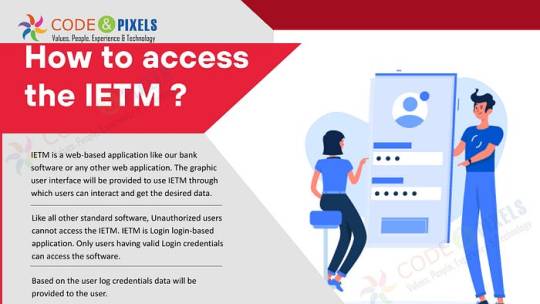
How to access the IETM ?
IETM is a web-based application like our bank software or any other web application. The graphic user interface will be provided to use IETM through which users can interact and get the desired data.
Like all other standard software, Unauthorized users cannot access the IETM. IETM is a Login - login-based application. Only users having valid Login credentials can access the software.
Based on the user log credentials data will be provided to the user.
IETM has 2 types of Users and one Administrator
Maintainer
Operator
If the operator logs in, the user gets all the content related to operator use, similarly if the maintainer logs in only maintenance-related content is visible for that user.
Ideally, all the content is available for both users, because the purpose of the IETM is to refer to the manual to fix the issue.
Administrators can create users who can see the user’s navigation and log-in history and interact with the users using user dashboards through Annotations.
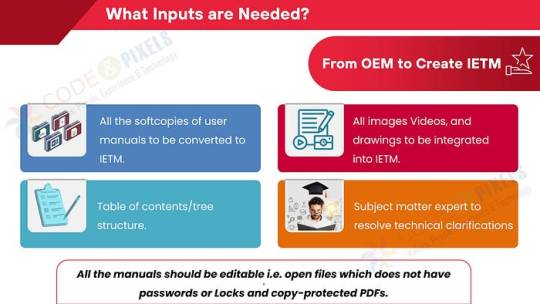
What Inputs are Needed? (From OEM to Create IETM)
All the softcopies of user manuals to be converted to IETM.
All images Videos, and drawings to be integrated into IETM.
Subject matter expert to resolve technical clarifications
Table of contents/tree structure.
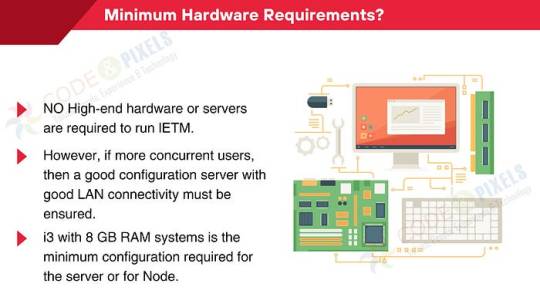
Minimum Hardware Requirements?
NO High-end hardware or servers are required to run IETM.
However, if more concurrent users, then a good configuration server with good LAN connectivity must be ensured.
i3 with 8 GB RAM systems is the minimum configuration required for the server or for Node.
Deliverables
BASED DB (Manuals are covered in the Database)
IETM VIEWER Software
User Manual and Installation Manual
Standards — compliance
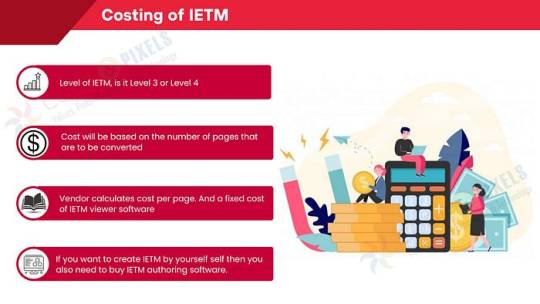
Costing of IETM: (Interactive Electronic Technical Manual)
Level of IETM, is it Level 3 or Level 4
Cost will be based on the number of pages that are to be converted
The vendor calculates the cost per page. And a fixed cost of IETM viewer software
If you want to create IETM by yourself self then you also need to buy IETM authoring software.
What are these Levels?
Level — 1 is any PDF file
Level — 2 is a PDF file with hyperlinks from the table of contents to the body etc.
Level — 3 is an HTML application. More hyperlinks, simple search, a content tree having log a screen with a hardcoded username and password and supplied in the format of EXE so that Windows can easily open
Level — 4 is Software plus Content/manuals converted as Database
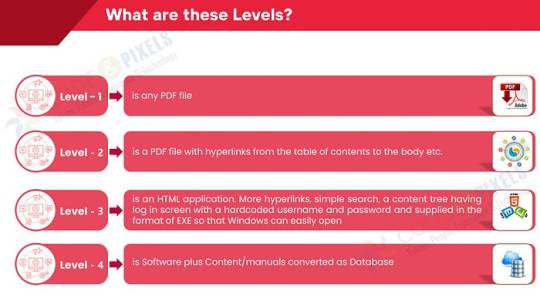
Regarding Level — 5, rest assured, till 2028 it will be Level — 4 only. As of now, there is nothing practically called Level — 5. Few are calling virtual reality and Augmented reality and Artificial intelligence Level — 5.
Pulling data from many user inputs and analyzing and giving results are done in Level — 5. IETM software cannot pull the data from various real-time points as No OEM will give the real-time information to third-party software directly. Yes, if the information is available offline, then that information can be imported into IETM and can be used as a reference.

#ietm#software#technology#ietm developement#ietm code and pixels ietm hyderabad#ietm software#elearning#code and pixels#ietm level iv#codeandpixels#ietm level 4 software requirements#technical documentation#ietm document#ietm documentation#interactive electronic technical manual#Ietm Service Providers#Ietm Software Designers of India#Software Development Company#Elearning Solutions Company#E Learning Content Development Company#Online Education#Digital Education#Digital Content#Software Development Solutions#Elearning#Ietm Developers#Econtent Development#Elearning Solutions Providers#Econtent Developers#Econtent
3 notes
·
View notes
Text

There are two major different types of Marshall Islands navigation charts: meddo and mattang. Meddo are like island maps, while Mattang are training tools that illustrated ocean movement, wind patterns and wave interactions around the islands. Mattang navigation stick chart is made from the flexible midribs of coconut fronds, with individual islands represented by the lashed junction of the fronds.
Stick charts are an incredible form of cartography that maps the prevailing ocean wave crests and directions. They enabled navigators to find their way across the vast distances between islands. Navigators and their apprentices memorised the charts before a voyage rather than consulting them during the journey. The use of stick charts ended after World War II, when electronic technologies were introduced to the Marshall Islands. Craftspeople make these charts today for display on the walls of homes both in the Marshalls and overseas. They stand as proud statements of their heritage as some of the world’s finest navigators.
It was collected by P.G. Black in 1906 and is one of the Australian Museum’s 200 Treasures, in the Westpac Long Gallery.
3 notes
·
View notes
Text
The 2022 DRAM Module Supplier of the Year is Kingston Technology

Kingston Technology created 2022 DRAM Module Supplier of the Year
Commanding the Market: Kingston’s Unassailable 78.12% Market Share
In a resounding affirmation of its industry prowess, Kingston Technology Company, Inc.’s affiliate stands tall as the paramount third-party DRAM module supplier for 2022. The latest revenue-based rankings by TrendForce unequivocally place Kingston at the zenith, boasting an astounding 78.12% market share, with a revenue totaling $13.5 billion USD. This achievement not only cements Kingston’s top-tier status but also marks an unparalleled 20-year reign as a recognized world leader.
A Decades-Long Reign: 20 Years at the Pinnacle
The enduring success of Kingston Technology is underscored by its two-decade-long dominance in the DRAM module sector. The company’s unbroken streak at the forefront speaks volumes about its unwavering commitment to excellence and innovation.
TrendForce Report: A Global Recognition of Kingston’s Supremacy
The accolades bestowed upon Kingston in the TrendForce report are a testament to its resilient performance in the face of a challenging market. Despite a 4.6% year-over-year decline in DRAM module sales industry-wide, Kingston’s revenue experienced a marginal dip while solidifying its position as the global leader.
The Power of Brand Scale: Kingston’s Robust Strategy
Consumer buying trends for electronic products encountered headwinds from high inflation, impacting several market players. However, Kingston’s robust brand scale and a comprehensive product supply chain acted as a shield, mitigating the decline and preserving its preeminence in market share rankings.
Market Landscape: Kingston’s Commanding Presence
The report reveals that the top five memory module houses globally accounted for a staggering 90% of total sales in 2022. Kingston, with its dominant market share of 78.12%, emerges as the indisputable leader. The chart below, sourced from TrendForce, outlines the rankings of the top 10 DRAM module suppliers in 2022.
Innovation Beyond Boundaries: Kingston’s Product Evolution
In 2022, Kingston’s award-winning Kingston FURY Beast DDR5 and Renegade DDR5 memory modules underwent a transformative redesign. The introduction of white heat spreaders offers users the freedom to choose the color that best aligns with their individual style. In an era where system aesthetics matter, Kingston provides modules that complement both traditional all-black systems and the burgeoning trend of all-white PCs.
Insights from Kingston: Navigating a Demanding Business Landscape
Iwona Zalewska, DRAM Business Manager at Kingston, EMEA, reflects on the 2022 findings from TrendForce. “The findings not only highlight Kingston’s ongoing expansion and adaptability but also underscore our resilience and significance within the industry,” she remarks. “Maintaining our top position for the 20th consecutive year is a testament to our enduring dominance.”
About Kingston Technology Europe Co LLP
Kingston Technology Europe Co LLP, alongside Kingston Technology Company, Inc., operates within the same corporate group. Kingston stands as the world’s largest independent manufacturer of memory products. From big data solutions to laptops, PCs, and IoT-based devices like smart and wearable technology, Kingston plays a pivotal role in delivering the technology that shapes our daily lives. The world’s foremost PC manufacturers and cloud-hosting companies rely on Kingston for their manufacturing needs, showcasing the trust placed in Kingston’s passion-fueled technology.
Read more on Govindhtech.com
#DRAM#KingstonTechnology#KingstonTechnologyCompany#DRAMmodule#fivememory#KingstonFURY#BeastDDR5#PCs#DDR5memory#technews#technology#govindhtech
2 notes
·
View notes
Text
I would like to add to this that in the 17th-20th centuries, a “computer” wasn’t an object, it was a job people had. It went from an informal task people did in support of engineering projects, navigation, and the sciences (especially astronomy), to a profession and a career during the late 18th-early 19th century. During the mid-late 19th century, women began to make up an increasing percentage of computers. Attempts to automate this industry began during the 19th century with Charles Babbage’s Difference Engine, but the Difference Engine was never completed and these automation efforts were largely abandoned in favor of stricter management practices.
During WWI, men were drafted into the army and the states had an increased demand for computers who were used to calculate gunnery tables, navigational charts, surveying aids, map grids, and more. From this point onwards computers were primarily women, and increasingly black women. In the interwar period, computers were used to run engineering simulations, process agricultural data from farms, and more.
In WWII, computers were again used as logistical support for their respective countries’ militaries, where in addition to everything they did in WWI they also worked on airframes, bombing routes, and optimal production of materials. They also worked on the Manhattan Project. After the war, computers were employed at NACA and NASA, and black women contributed heavily to the rocket trajectory calculations used in the Apollo program.
Electronic computers and calculators began to be developed by the end of WWII. Once they became widespread, this historically women-dominated profession vanished completely. A lucky few became the world’s first computer programmers. The rest simply found out their jobs were gone and never coming back.
The development of electronic computers and calculators has been an absolute boon for engineering, mathematics, the sciences, and society at large in countless ways. And I think it’s important to understand that this didn’t come without a cost, that the development of computers was primarily an effort at automation and as such exacerbated the exploitation of the working class, and that AI should be understood in terms of class conflict as well.
So yes, all of the differences between AI and electronic calculators/computers are accurate, but also electronic calculators/computers did destroy an entire industry that was historically dominated by women, they did take people’s work from them, and those workers were right to fear for their jobs.
'People are panicking about AI tools the same way they did when the calculator was invented, stop worrying' cannot stress enough the calculator did not forcibly pervade every aspect of our lives, has such a low error rate it's a statistical anomaly when it does happen, isn't built on mass plagiarism, and does not obliterate the fucking environment when you use it. Be so fucking serious right now
#the main difference between AI and electronic computers I’d say is that AI outputs complete garbage and yet is still being forced upon us#and the only way this makes sense is if you understand it in terms of class conflict#it doesn’t matter that it outputs garbage. it’s good enough that it can justify layoffs and reduced wages
107K notes
·
View notes
Text
Overcoming Prior Authorization Challenges: Patient & Provider Views
Prior authorization is a cost-containment process used by health insurers to determine if a prescribed procedure, service, or medication will be covered. While it aims to ensure the appropriate use of healthcare resources, both patients and providers often find themselves caught in a frustrating and time-consuming loop. Delays, denials, resubmissions, and inconsistent payer policies can disrupt care delivery and contribute to poor patient experiences.
This article explores the challenges associated with prior authorization and presents patient and provider perspectives, while offering practical strategies to streamline the process.
Understanding the Pain Points
From the Patient's Perspective
Patients undergoing prior authorization often face the following issues:
Delayed Treatment: A common complaint is how long it takes to get approvals, especially for urgent medications or procedures. This delay can worsen medical conditions and create anxiety.
Lack of Transparency: Patients are often not informed upfront that their prescribed treatment requires prior authorization. The surprise factor can lead to confusion and a sense of helplessness.
Increased Financial Burden: When prior authorization is denied or delayed, patients may pay out of pocket, skip treatment, or opt for less effective alternatives.
Communication Gaps: Patients are rarely involved in the communication loop between provider and insurer, making it hard to track the status or understand next steps.
From the Provider's Perspective
Healthcare providers, including physicians, medical staff, and billing teams, struggle with:
Administrative Overload: Completing PA requests manually involves faxes, phone calls, and redundant data entry—consuming valuable clinical time.
Inconsistent Payer Rules: Every insurance company—and sometimes each plan—has different criteria. Staying current with policy updates is a constant battle.
Denied Authorizations: Even medically necessary services can be denied, often requiring appeals or peer-to-peer reviews that take up resources.
Staff Burnout: The burden of navigating prior authorizations contributes significantly to administrative fatigue among healthcare workers.
The Bigger Picture: Impact on Care Quality and Costs
A 2023 American Medical Association (AMA) survey revealed that 94% of physicians reported that prior authorizations cause delays in patient care. Moreover, 30% of patients reported abandoning treatment due to prior authorization issues. These delays not only risk patient health but also increase downstream costs through complications, hospital readmissions, and emergency visits.
Strategies to Overcome Prior Authorization Challenges
1. Automating the Process
Technology-driven solutions, such as electronic prior authorization (ePA) platforms, can reduce paperwork, minimize manual errors, and accelerate approvals. Integrated with EHRs, ePA tools allow providers to:
Submit requests directly from the patient’s chart
Receive real-time status updates
Access payer-specific requirements instantly
ePA adoption has been shown to reduce approval time from days to hours, sometimes even minutes.
2. Outsourcing to Prior Authorization Specialists
Healthcare organizations can outsource PA services to specialized companies like Practolytics. These experts manage the entire authorization lifecycle—from verification to appeals—ensuring faster approvals and higher success rates. Outsourcing also frees clinical staff to focus on patient care, not insurance hurdles.
3. Training and Standardized Workflows
Consistent training across teams helps reduce errors and denials. Standardizing internal workflows—such as creating templates for common procedures or medications—can also speed up the submission process. Clinical decision support tools can flag treatments that require PA during order entry.
4. Proactive Communication
Providers who educate patients early about prior authorization requirements help manage expectations. Practices can also implement patient communication protocols to update them on status changes or anticipated delays. Keeping patients informed fosters trust and reduces anxiety.
5. Data-Driven Improvements
Tracking metrics such as:
Average approval time
Denial rates by payer
Number of appeals required
Staff time spent per authorization
…helps identify inefficiencies and target areas for improvement. Data can also be used in payer negotiations or to challenge recurring denials.
The Role of Policy and Advocacy
Many industry groups, including the AMA and MGMA, advocate for prior authorization reform. Proposed changes include:
Requiring insurers to offer real-time electronic PA
Enforcing time limits for decisions (e.g., 24 hours for urgent requests)
Mandating transparency in PA criteria
Reducing or waiving PA for high-performing providers
Healthcare providers and patient advocacy groups can support such initiatives by sharing real-world data and joining coalitions that push for legislative change.
Patient-Centric Solutions
Here’s how healthcare practices can empower patients during the PA process:
Offer Clear Instructions: Educate patients on what prior authorization means and what documents may be needed.
Assist with Appeals: Some practices guide patients in writing appeal letters or provide templates to speed up the process.
Provide Alternatives: If a PA is delayed, offer alternative medications or interim treatments when appropriate.
Leverage Portals: Use patient portals to send status updates and documents securely, reducing phone call volume and stress.
Real-World Example: Prior Authorization Done Right
A multi-specialty clinic in Texas partnered with Practolytics to streamline their PA process. Within 90 days:
Approval turnaround dropped from 5.2 days to 1.4 days
Denials reduced by 48%
Provider satisfaction scores increased
Billing teams saved over 20 hours weekly on manual tasks
This transformation was made possible by outsourcing PA tasks, using automation tools, and implementing real-time reporting dashboards.
Conclusion
Prior authorization may be a necessary process, but its implementation often leads to frustration, delays, and poor experiences for both patients and providers. By recognizing the shared challenges and adopting smarter workflows, better tools, and patient-centric practices, healthcare organizations can dramatically reduce the burden of PA.
The future of prior authorization lies in automation, collaboration, advocacy, and communication. When providers and patients work together—supported by technology and specialized services like Practolytics—the roadblocks of today can be turned into smoother pathways toward faster, better care.
0 notes
Text
0 notes
Text
0 notes